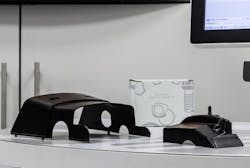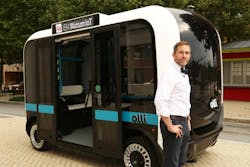And here we've been expecting Amazon package trucks that'll 3D print items ordered onboard as the trucks rush to deliver them. It might not be quite that dramatic a change yet, but 3D printing already is influencing trucking and transportation in a number of ways — and maybe just as significantly.
Yes, the patent Amazon was awarded in February last year for 3D printing on trucks made some waves and has been talked about as a potential disruptor of current trucking and supply chain norms. That could be even more the case if the online marketplace giant combines the idea with its equally buzz-generating concept of sending delivery drones to your door.
Cast your gaze a bit nearer on the horizon, though, because 3D printing as of right now is bringing new possibilities and meaningful changes in areas like truck parts availability/ inventorying, production costs, and time-to-market for new ideas. Here's a glimpse at what's happening and is likely to expand going forward in the trucking industry.
1. Replacement truck parts will soon be printed on demand — and that could be applied to older/ discontinued models as well.
One of the latest developments in 3D printers and trucking came from European shores, and for the time being it hasn't directly crossed over to the North American market. Still, starting in September, Mercedes-Benz says 30 spare parts for its Actros series trucks will be 3D printed, which creates several advantages.
The parts all will be of "consistent manufacturer's quality" and can be made up "at the touch of a button," the truck maker notes. The ability to make a single, given part on demand is exponentially less expensive than a traditional manufacturing run for that part, for one thing, and once a 3D printer is in place for a specific locality or region, it also eliminates the typical requisite supply and distribution network to make such a part available.
That takes a good deal of cost and time out of the maintenance parts equation, and it could also mean trucks get up and running quicker with less downtime when a trip to the shop is needed. But 3D printing spare parts for trucks also means there's nothing stopping those parts from being produced in the years to come — essentially indefinitely.
"Thus, even after several decades, rapid supply to the customer is ensured via the Mercedes-Benz Logistic Supply Chain through all the sales stages — all over the world," the OEM states in a release. Andreas Deuschle, head of marketing and operations in Mercedes-Benz Trucks' Customer Services & Parts Division, promises there's lots more to come: "3D [printing] offers many more possibilities; this is why we shall be rapidly extending the production of 3D printed parts."
2. All new transportation products are being manufactured with little machining and production infrastructure.
A modern-tech trifecta — 3D printing, autonomous operation/artificial intelligence and all-electric power — materialized suddenly in a commercial transportation application in mid-June. You can find it in National Harbor, MD, a popular convention, shopping and dining destination, and possibly elsewhere soon.
It's called "Olli," a minibus/ getabout vehicle that looks a bit like it could have been dispensed from an electronics vending machine offering iPods, headphones and the like. The vehicle can shuttle up to a dozen people around, and while they're riding they can converse with it and ask questions — and very likely get good answers — because the AI interface is powered by IBM's Watson Internet of Things technology.
Olli is made by Local Motors, a new company headquartered in Phoenix that just opened a facility in National Harbor. Interestingly, IBM notes that the Watson tech is for passenger information and conversation, the "cognitive rider experience," rather than autonomous operation. Local Motors says Miami-Dade County is exploring and has shown "immediate interest" in getting Ollis rolling on the streets of Miami.
In this case, 3D printing has turned most of the manufacturing supply and distribution model into a big "not applicable" check box for Local Motors. The first Olli will remain in National Harbor till the end of this summer and the public will get a few "select times" to take a spin, according to the company. And should the vehicle garner the attention of other municipalities or locations, local production would be a matter of getting an appropriate large-scale 3D printer there.
So not only could Local Motors make Olli with low production/ setup costs and very quickly, the company also saves by crowd-sourcing some design work (and you thought jobs only get outsourced, didn't you?). Olli was penned by Colombian-native 20-something Edgar Sarmiento, and Local Motors hopes its National Harbor facility — which is also an informational, showcasing and learning center — will "serve as a public place where co-creation can flourish and vehicle technologies can rapidly advance."
3. Development ideas are being realized and brought to market considerably faster and at much lower cost.
For as long or likely longer than any other vehicle OEM, Ford Motor Co. has been pushing the boundaries of the manufacturing process with 3D printing. While it has caught the public's attention quite a bit in the last several years, "in 1986, 3D printing was called stereolithography, and Ford bought SLA 3, the third 3D printer ever made," the company states in a release from late 2013.
Then last summer, Ford announced it had begun working with Carbon3D in December 2014. Carbon3D developed a process called CLIP, for Continuous Liquid Interface Production, which allows for much faster, smoother 3D printed products. "The resulting parts boast mechanical properties that are applicable for a range of needs of Ford vehicles," the OEM stated. Ford refers to 3D printing aptly as "additive manufacturing," and it's easy to see what the process adds to traditional vehicle development and production.
"Ford's been using 3D printing for over 25 years for everything from early concept prototypes to prototypes that are actually runnable and testable on to some very limited production tooling," says Harold Sears, additive manufacturing technical expert at Ford. "It'll allow the engineers to shorten that timeframe [of production] down and do that iterative testing and get through it much quicker. The end result is higher-quality products and more cost-effective products for our customers."
As an example, Ford demonstrated that it's using advanced CLIP 3D printing to make parts for Transit vans and Focus passenger cars. "In this process, we're able to cure the layer while maintaining a continuous liquid interface, so instead of having that step-wise, layer-by-layer process, we're able to do it more continuously," states Ellen Lee, team leader for additive manufacturing research at Ford. "It can be done faster and the properties of the part are not layered — they're stronger in both the printed direction and the other direction."
So if you've seen only rough-looking, layer-by-layer-cured 3D printed parts and products that look a bit like Maple tree bark, think again. While 3D printing has allowed Ford to make up prototype/ concept parts for its cars and trucks like the new Super Duty pickups faster and cheaper, the company is also examining how 3D printing can be employed in production and spare parts manufacturing.
"We are researching the use of 3D printing for production or replacement parts, with a focus on quality and durability," Ford spokesman Kristen Simpson tells Fleet Owner.
Going forward, expect to see and hear more of 3D printing as processes advance and the technology makes more inroads into trucking — it may already be changing development, production, supply chains and the aftermarket/ replacement parts markets more than you think.
And what about those Amazon trucks with onboard 3D printers making up ordered items on the fly? We wouldn't discount the possibility.






